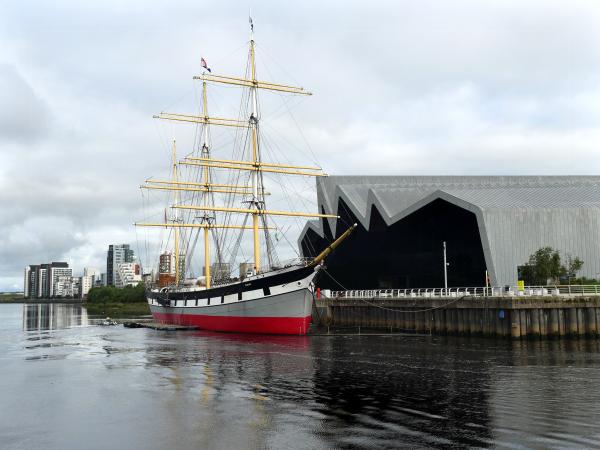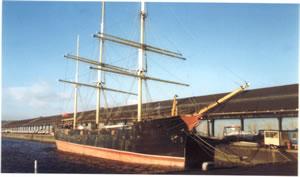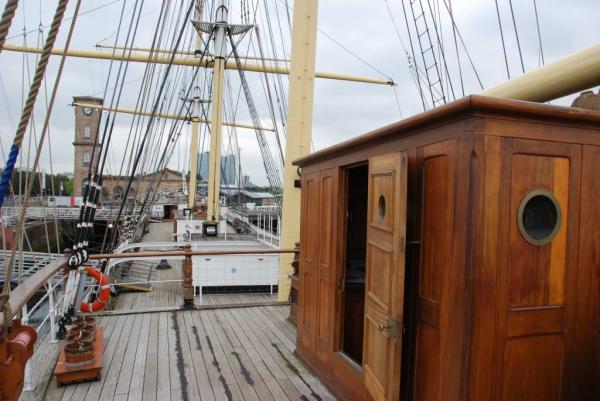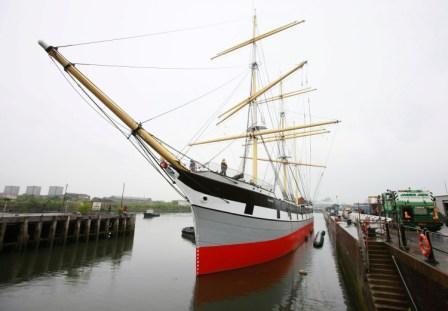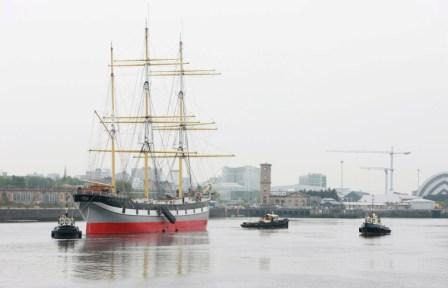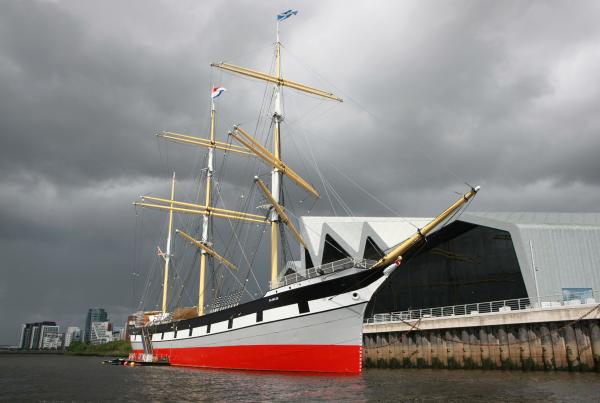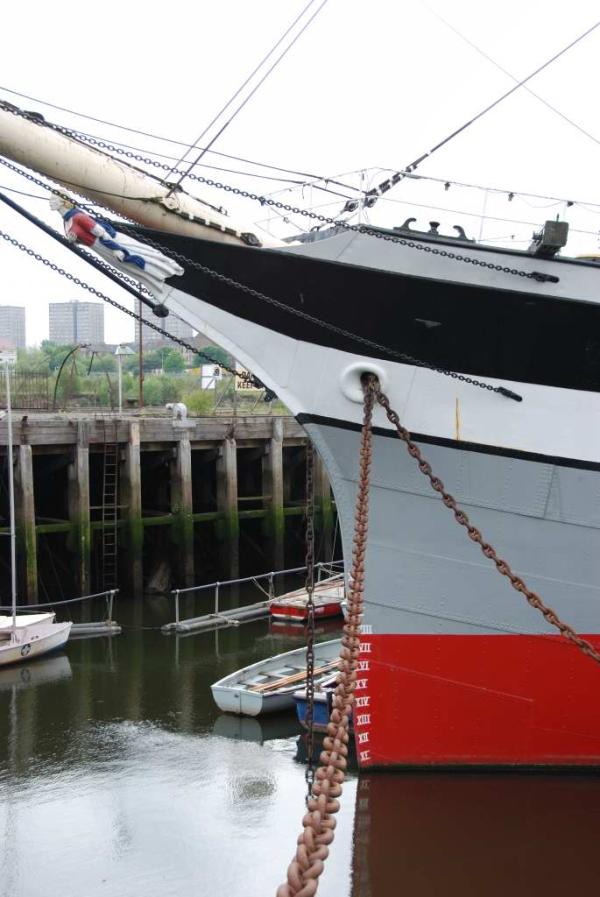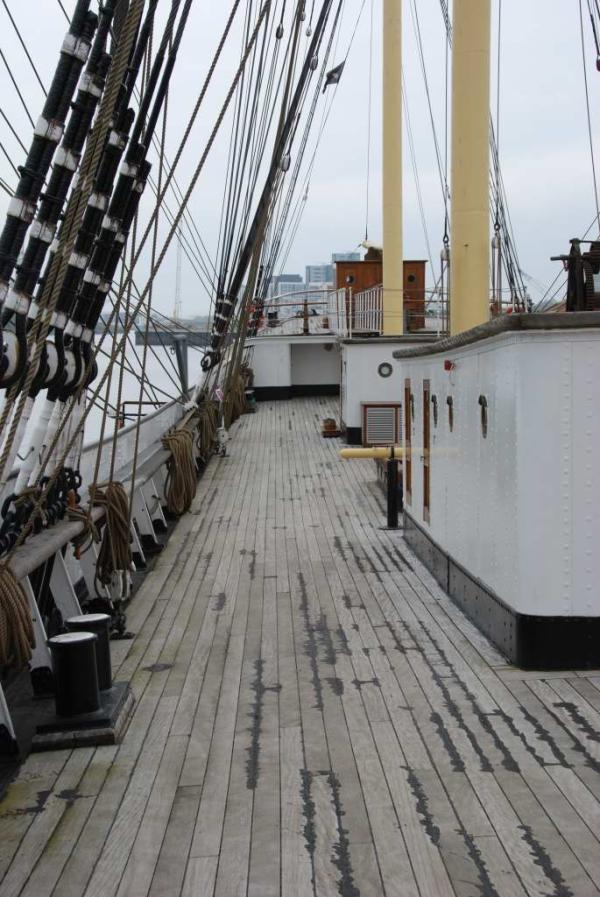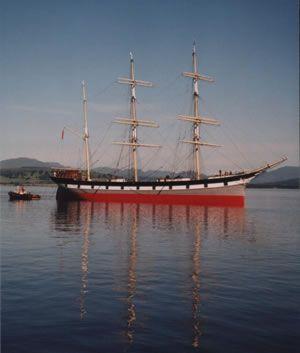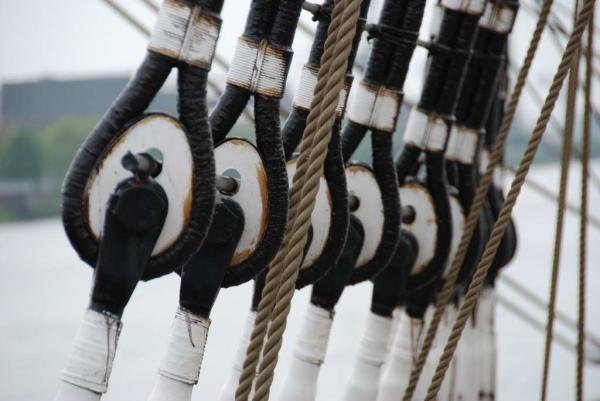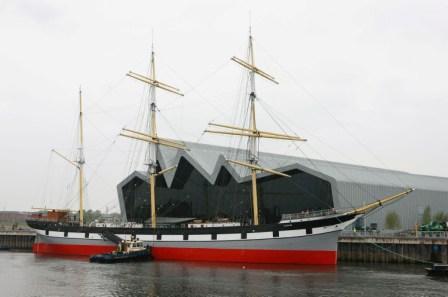

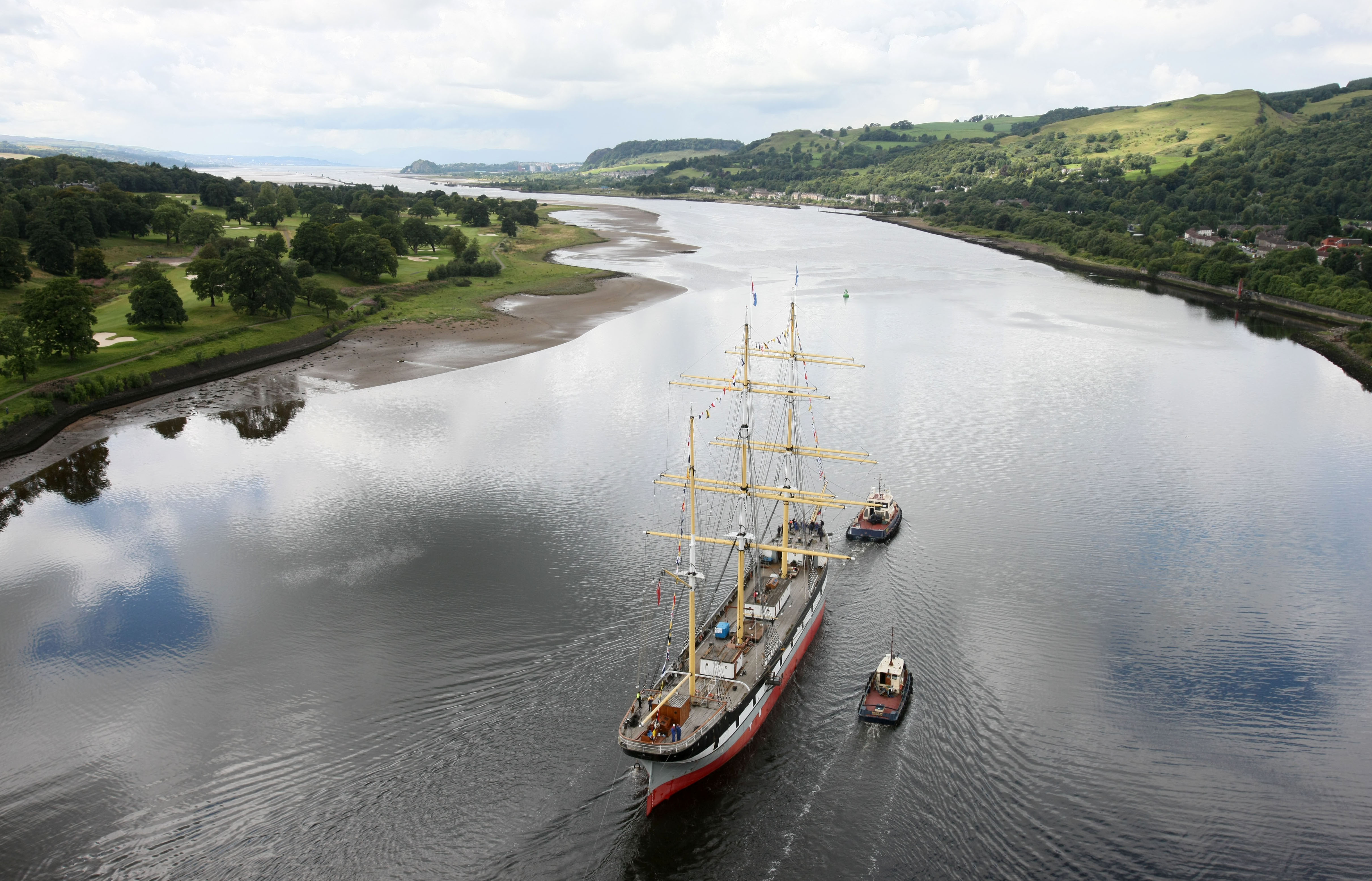
Previous names
- 1899 - 1919 Islamount
- 1919 - 1921 Clarastella
- 1921 - 1991 Galatea
Details
Construction
Dimensions
History
The three-masted barque GLENLEE yard number 324, registration number 102574, and signal letters PMVL, was launched on 3 December 1896 from the Bay Yard of Anderson Rodger & Co., Port Glasgow.
Initially managed by Archibald Sterling, GLENLEE completed its maiden voyage around Cape Horn to Portland, Oregon. Following this voyage, the ship was sold in London on 25 March 1898 to Dundee ship manager Robert Ferguson and renamed ISLAMOUNT. It was registered as a single-ship company.
In July 1905, ISLAMOUNTwas sold to Robert Thomas & Company of Liverpool and became part of the Flint Castle Shipping Company. Over the next thirteen years, the vessel completed seven long-distance voyages under their management, including five global circumnavigations and fifteen passages of Cape Horn.
In early 1918, while still at sea, the vessel was acquired by the Shipping Controller and registered in London under the management of John Stewart & Co. After the First World War, ISLAMOUNT was sold at auction on 17 December 1919 to unnamed owners, through agents David Bruce & Company of London and Lauro & Fantozzi of Genoa.
Major modifications were made during the winter of 1920–21: twin Ansaldo-FIAT diesel engines were installed, along with a donkey boiler, new electrical systems, fuel and trim tanks, and a tween deck. By January 1921, the ship had been renamed CLARASTELLA and was registered in Genoa.
On 14 January 1922, CLARESTELLAwas purchased by the Royal Spanish Navy for conversion into a sail training vessel. The refit took place in Trieste under the direction of Spanish naval architect Lt. Col. Nicolás Franco Bahamonde—brother of future Spanish leader General Francisco Franco. The conversion was extensive, adding accommodation for 17 officers, 30 petty officers, and 260 cadets. Large water tanks were installed in the hold, along with additional lifeboats, generators, pumps, saluting guns, and other training equipment. The vessel was renamed GALATEA.
By 1959, GALATEA had been reassigned as a static rigging training ship at La Graña Naval Base. Ongoing leaks led to significant replating amidships up to the load waterline, extending the vessel’s service life at the base. GALATEA was decommissioned in February 1962. An estimated 4,000 officers and crew had served aboard during its time in the Spanish Navy.
In preparation for Expo ’92 in Seville, a plan was made to convert GALATEA into an exhibition ship. The vessel was towed to Seville, with rigging transported separately. However, the project collapsed. With no further interest or support, the ship suffered vandalism, theft of fittings, a sinking, and a serious fire. Despite heavy damage, the vessel remained the property of the Spanish Navy.
On 30 June 1992, Clyde Maritime Trust Ltd purchased the hull at auction, represented by Hamish Hardie. After extensive preparation, a towing certificate was issued, and the vessel was towed over nine days to Greenock, arriving on 9 June. Shortly after arrival, the original name—GLENLEE—was restored, and conservation work began at the Queens Dock pumphouse in Glasgow.
GLENLEE opened to the public on 13 August 1999, following an appearance at the 1999 Tall Ships Race in Greenock. In 2011, the vessel was relocated to a purpose-built berth at the new Riverside Museum, on the former J. & T. Inglis shipyard site at Pointhouse, Partick.
Today, GLENLEE continues to welcome visitors aboard, offering a vibrant learning programme and serving as a unique venue for events. As one of only a handful of Clyde-built sailing ships still afloat, GLENLEE remains a vital link to Scotland’s maritime heritage.
Significance
1. What is the vessel’s ability to demonstrate history in her physical fabric?
GLENLEE was one of a group of ten, steel, riveted sailing vessels built to a standard design in an era which, while overlapping with the growing employment of steam at sea, was the apogee of design and function for this purpose. Riveting was significant in the development of Clyde Shipbuilding between 1800 and the end of the Second World War and, as such, the vessel demonstrates the emergence of a mass production system for shipping.
The surviving steel parts of her structure dating from the 1896 build are: the keel, vertical floor plates, frames, beams, deck stringer plating and the riveted shell plating above the waterline, most of which were produced and fabricated locally. The beams under the main deck are original and display the maker’s names in places. Those beams seen in the poop are not original: the poop deck and fittings were destroyed by an arsonist in 1991. The whole poop deck and internal accommodation is a reconstruction, based on detailed research of similar vessels and existing documents.
The underwater plating was largely replaced with welded plates and considerable over-plating by the Spanish Navy in 1981 although with some of the original riveted plates left in place. The ship, despite the refurbishment and adaptation to a 360-man crew in 1922, also retains two original and very large, riveted, metal water tanks dating from 1922 at the latest, currently in a poor state of conservation.
The decks under the fo’c’sle and in the forepeak are thought to date from between 1896 and 1922. All other decks were re-laid during the conservation work carried out in 1997/8. The anchor capstan and windlass are believed to date at least from 1922, when the vessel was substantially refitted as a sail training ship by the Royal Spanish Navy. These have been freed from rust, restored and are now fully operative.
The steel forward deckhouse is a replica from 1896, as are the internal fittings, and the aft steel deckhouse is a replica based on the same lines although the original would have been of timber construction.
The masts and yards are welded steel tubular fabrications installed by the Spanish Navy, circa 1954, after substantial hurricane damage during an Atlantic voyage. To transport them economically to the UK in 1993, they were cut into manageable lengths and rebuilt. The masts were stepped and the whole rig reinstated during the conservation programme from 1997-1999.
Two Italian “Ansaldo” diesel engines fitted under Italian ownership have been retained in the colours of the Spanish Navy, as has one diesel generating set driven by a classic Ruston and Hornsby three-cylinder model built in Peterborough in 1922 which is on display. Volunteers have cleaned and, to some degree, restored the electrical switchboard installed by the Spanish Navy in 1922. These are all examples of the changes experienced during GLENLEE’s long service life.
GLENLEE has no sails set and is intended to remain in static preservation but has a lower topsail, hand-made in 1999, which is tailored to fit and could be bent to the relevant yard. This is on display in the cargo hold.
The ship’s wheel was destroyed in a fire in 1991 but the yoke and worm-screw steering machinery is believed to be original or to date at the latest from 1922 and is set in a restoration wooden housing, or steering box, on the aft end of the poop deck.
Replicas of her two lifeboats, as originally built in 1896, are on board as well as replicas of the Captain’s gig and a pinnace; all based on original research. The navigation lighthouses on the fo’c’sle have been replicated, while the davits for launching the lifeboats and the securing boat chocks are under construction.
A replica working example of the 1896 bilge pump is also under construction and will be situated in its correct position at the foot of the main mast. There are also plans for the installation of the running rigging for the square sails on the foremast, to give some impression of the lines and function of the ship. All these items, once completed, will help return her profile closer to that at launch.
2. What are the vessel’s associational links for which there is no physical evidence?
GLENLEE has significant national associations with Scotland and the Clyde seen through the design of the vessel, in her build and ownership. GLENLEE was constructed by shipbuilder Anderson Rodger for the Glasgow shipping firm of Archibald Sterling & Co Ltd at the Bay Yard, Port Glasgow and typifies the company strategy of standardising hull forms and components, first in iron and then in steel. The shipyard had established a reputation for the construction of large vessels intended for long-haul, slow transport of bulk cargos, building some 713 ships between 1875-1917. As an emblematic survivor, GLENLEE demonstrates this efficiency of build and the subsequent profitability to the shipowner; by having the distinction of being one of only five remaining Clyde-built sailing ships afloat in the world and the only one in the British Isles.
The steel with which GLENLEE was built came from local Lanarkshire steelworks, the men and boys who built ships such as this lived on the banks of the River Clyde, and the men who sailed her embodied the maritime sea-going tradition of the West Coast and the British Isles. GLENLEE is symbolic of the era of marine industrialisation in construction, of global trade in the cargos carried, and of those who designed, built and sailed such ships.
GLENLEE is significant for having survived both World Wars. Fully employed in the First serving the needs of a war economy and the requirements of the UK and its dominions in Southern Africa and Australia, GLENLEE delivered general cargo, then coal and later case oil, nitrates or wheat. In 1918, the vessel came under the direction of the British Shipping Controller in London, as part of the organisation of shipping under Lloyd George for the war effort. At the end of her final voyage under the British flag, GLENLEE was sold almost immediately to an Italian firm based in Genoa, the result, so it is told, of communication with Winston Churchill. During the Second World War, in Spanish ownership, the ship continued to sail and was regarded as a neutral vessel: the Spanish Flag was clearly painted on the sides to avoid attack from either side and especially from submarines.
Between 1896 and 1919, GLENLEE circumnavigated the globe four times and survived the storms of Cape Horn on fifteen occasions. Renamed in 1898 as ISLAMOUNT, later as the Italian-owned CLARASTELLA, and then as the Spanish ship GALATEA from 1922-1993, the vessel visited ports all around the world. The countries visited by the ship and those in which she has had influence due to her trading and naval history, continue to have an active interest in her. The connection is especially strong with Spain and in her home port of Ferrol where the vessel was decommissioned in 1962 but remained as a shore-based training facility.
Considerable research has been carried out in relation to GLENLEE. At first into her overall history and voyages through archival and documentary investigation, and these are reasonably comprehensive. More recently, the emphasis has been, and continues to be, on the history of the men who sailed on the ship in the period under British ownership: through genealogy research, contact with descendants and discovery of documents and photographs. There are also substantial sources of accounts from those Spanish trainees, termed ‘galateanos’, who spent some of their formative youth on board.
GLENLEE has been recorded on the National Register of Historic Vessels since 1996 and is part of the National Historic Fleet.
3. How does the vessel’s shape or form combine and contribute to her function?
GLENLEE has graceful lines and is the only surviving example of her type in the UK: epitomising the last epoch of sailing ships, circling the seas of the world as bulk carriers in the late nineteenth and early twentieth centuries at the peak of empire and global trading development.
Ships such as GLENLEE were the first long distance cargo vessels which started globalised trade: in bulk goods such as grain, coal, nitrates, case oil (kerosene) as well as general cargoes. The robust riveted steel hull was designed with volume in mind and gave some 50% more capacity than the slimmer tea clippers. They also operated with much smaller crew numbers, all of which made them fit for purpose and profitable for their owners.
When in Italian ownership, the vessel was converted from a wind driven barque to a twin screw, auxiliary barque propelled by two Italian “Ansaldo” diesel engines and tanks for holding 46 tons of fuel were also fitted to facilitate the change.
GLENLEE is preserved afloat by the Clyde Maritime Trust in her original heritage setting on the River Clyde, to which she was towed back from Spain in 1993. Located as a static exhibit and visitor attraction berthed beside the Riverside Museum, GLENLEE is based on the waters where she once plied her trade and is symbolic of the role and significance of “Clydebuilt” craft to the City of Glasgow and the world.
Sources: Clyde Maritime Trust, April 2021
Key dates
-
1896
Built by Anderson Rodger & Co. at Port Glasgow for Sterling & Company
-
1898
Acquired by The Islamount Shipping Co. Dundee
-
1905
Acquired by The Flint Castle Shipping Co. Liverpool
-
1919
Bought by an Italian Shipping Company and renamed CLARASTELLA
-
1922
Entered the Spanish Navy, was renamed GALATEA and underwent modifications for use as a sail training vessel
-
1959
Reassigned as a static training vessel
-
1962
Decommissioned
-
1992
Vessel lay derelict in Seville and was bought at auction by the Clyde Maritime Trust
-
2009-2011
Underwent a full refurbishment and was transferred to lie outside the new Riverside Museum, Glasgow
-
2021
Received an award of £250 from NHS-UK for being Static Flagship 2021
Grants
-
August 2023
£1.8 million received for the National Heritage Memorial Fund to clear a backlog of repairs built up during the pandemic.
-
August 2022
Tall Ship Glenlee has been awarded a £35k grant to reimagine their visitor experience from Museums and Galleries Scotland's Museum Development Fund.
-
June 2022
Tall Ship Glenlee has been awarded a £5000 grant of from Visit Scotland’s Year of Stories 2022 Fund for ‘The Apprentice’s Tale’, an exhibition and storytelling event centred around the logbook of Ernest Andersen (Andy), an apprentice on board the ship during the last months of WWI.
-
April 2022
A grant of £51,481 was awarded to the Clyde Maritime Trust by Museums Galleries Scotland's Capital Resilience Fund.
-
2021
Received an award of £250 from NHS-UK for being Static Flagship 2021
-
2015
A sustainability grant of £1000 for remedial work was made from ,the Strategic Development Fund of National Historic Ships UK
-
2007-2008
The Heritage Lottery Fund awarded £24,900 for a theatre production 'The Tall Ship Tales'
-
2001-2002
The Heritage Lottery Fund awarded £108,750 for Interpreation
-
1999-00
The Heritage Lottery Fund awarded £180,000 to complete restoration work
-
1996-1997
The Heritage Lottery Fund awarded £1,148,000 for restoration and development
-
1992
The National Heritage Memorial Fund awarded £50,000 for repatriation
Sources
Books
Allen, E. (2011) Glenlee. Glasgow: Clyde Maritime Trust Ltd. ISBN 978-0-9569115-0-6.
Castle, C. and MacDonald, I. (2005) Glenlee: The Life and Times of a Clyde-Built Cape Horner. Glasgow: Brown, Son & Ferguson. ISBN 0-85174-727-2.
Delibes, M. (1990) The Stuff of Heroes (Madera de Héroe). Translated by F.M. López-Morilla. New York: Pantheon Books. ISBN 0-394-57746-9.
Hardie, H. (2004) The Dutchman Had Guilders: The Rescue and Restoration of the Clydebuilt Three-Masted Barque Glenlee. Glasgow: Clyde Maritime Trust Ltd. ISBN 0-947649-11-5.
Mason, C.M. (n.d.) Five Thousand Days: The Voyages of the Clydebuilt Barque Glenlee (Renamed Islamount 1898) under the Red Ensign 1897-1919. Glasgow: Clyde Maritime Trust Ltd.
Ramsay, I. (2014) Glenlee: How a Riveted Sailing Ship Was Built. Glasgow: Clyde Maritime Trust Ltd.
Journal and Magazine Articles
Brett, O. (1954) ‘The Galatea visits New York’, Sea Breezes, Vol. 17 (New Series), May, p. 355.
Brett, O. (1956) ‘Godfrey’s ship portraits’, Sea Breezes, April, p. 309.
Castle, C. (1993) ‘Glasgow’s Windjammer’, Ships Monthly, January, pp. 39-39.
Castle, C. (1997) ‘Restoring Glasgow’s Windjammer’, Ships Monthly, July, pp. 30-33.
Davies, T.D. (1936) ‘The last voyage of the Islamount under the Red Ensign’, Sea Breezes, No. 199, Vol. XX, June, pp. 258-259.
Fieldwood, C. (1952) ‘South of the Cape’, Sea Breezes, Vol. 13, January–June, pp. 398–400.
Hannavy, J. (2013) ‘The Tall Ship in Glasgow’, Ships Monthly, Vol. 48, No. 9, September, pp. 56–59.
Nunes Segura, J. (1994) ‘Galatea under sail’, Sea Breezes, Vol. 68, No. 580, April, centre pages.
Richards, T.D. (1934) ‘Retrospect of old ships and old timers’, Sea Breezes: The PSNC Magazine, No. 177, Vol. XVII, August, pp. 210–211.
Richards, T.D. (1958) ‘Nasty letters’, Sea Breezes, June, p. 453.
Unknown author (1934) ‘Unlucky Olivebank’, Sea Breezes, Vol. XVIII, p. 236.
Unknown author (2011) ‘The exclamation mark: after a fabulous refit and move to Riverside Museum, Glasgow’s Tall Ship expects to welcome even more visitors’, Glasgow Council Magazine, April–May, p. 18.
Watson, H.R. (1936) ‘The Islamount in peril: a mishap at Port Phillip (Melbourne) Heads’, Sea Breezes, No. 195, Vol. XX, February, pp. 135–137.
Waters, C. (1994) ‘The Glenlee comes home to Scotland’, Sea Breezes, Vol. 68, No. 580, April, pp. 291–293.
Reports and Other Publications
Brouwer, N.J. (1992) International Register of Historic Ships. 2nd edn. St Ives: Anthony Nelson, p. 150.
Clyde Maritime Trust Ltd. (1995) Glenlee: Clydebuilt 1896. Glasgow: Clyde Maritime Trust Ltd.
Clyde Maritime Trust Ltd. (1995) Schedule of Drawings and Documents. Glasgow: Clyde Maritime Trust Ltd.
Glasgow Council Magazine (2011) ‘The exclamation mark: after a fabulous refit and move to Riverside Museum, Glasgow’s Tall Ship expects to welcome even more visitors’, April–May, p. 18.
Own this vessel?
If you are the owner of this vessel and would like to provide more details or updated information, please contact info@nationalhistoricships.org.uk

